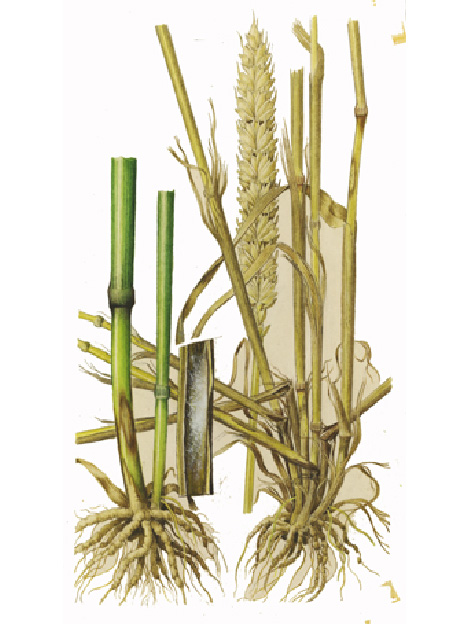Wheat eyespot
Pseudocercosporella herpotrichoides
Damage symptoms

- Unspecific brownish discolorations can already be seen on young plants on the outer leaf sheaths, but do not allow a clear diagnosis with the naked eye.
- Early dieback of young plants during heavy disease pressure in autumn.
- Medallion spots as a symptom of further disease progression. They form from shooting on the lower shoot sections, are light gray to light brown, and usually have dark borders. At these points, the fungus has already overgrown the culm and destroyed the culm tissue.
- Buckling of the culms is the result of severe infestation. This folding can also occur without external weather influences; the culms then usually lie crosswise in the stand in nests.
- Formation of scab grains or premature death of the ears (whitening). Even in the case of less severe infestation, nutrient transport into the ear plants is impeded by the destruction of the conducting vessels.
Host plants
The eyespot disease affects all cereals, with the winter forms of wheat and triticale most at risk. Other host plants include a number of cultivated and wild grasses.
Two strains (pathotypes) can be distinguished in eyespot. The W-type(Tapesia yallundae): almost exclusively attacks wheat, the R-type(Tapesia acuformis) is found on all cereals to the same extent.
Propagation and transmission
The disease is favored by mild winters and cool, damp weather conditions in spring. Infection usually starts from the crop residues in the soil, in which the fungus can survive for at least two years. Rain splash disperses the fungal spores over small areas in the stand and they enter the tissue through dying cotyledon sheaths (coleoptiles) or leaf sheaths. From this entry point, the fungus continues to grow into the culm and begins to destroy the culm tissue. The optimal conditions for infection are mainly late fall and early spring, when high humidity and temperatures between 5 °C -10 °C prevail.
Prevention and control
- Crop rotation planning is one of the most important preventive measures to minimize the risk of infestation. Tight cereal rotations, especially with a high proportion of wheat and cereals (triticale), increase the risk considerably.
- Other crop management measures include selecting low-susceptible varieties and eliminating volunteer cereals by stubble cultivation.
- Chemical or biological control of eyespot: targeted control by fungicides (see list of plant protection products approved in Austria) is possible, but at the optimal time of spraying(BBCH32) the symptoms of the infestation are hardly visible.
Specialized information
A forecast model for eyespot in winter wheat and winter barley is offered on thewarning service page of the Chambers of Agriculture. With these warnings, a possible infestation in the individual regions can be better assessed.
Last updated: 02.10.2025
automatically translated